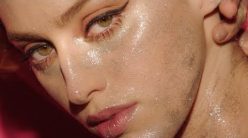nm. Riboflavin (RF), also known as vitamin B2, belongs to the class of water-soluble vitamins and is widely present in a variety of food products. The assay can reach as low as 0.30 parts per million with high levels of accuracy and sensitivity. (RD-RF), including absorption and emission spectra, two-photon excitation spectra, and fluorescence pH dependence. The wavelengths of the emitted maxima of the blue, green, yellow and red lights were 463, 529, 589 and 632 nm, respectively, and the spectral widths at half height ( W1/2) were 23, 31, 16 and 14 nm, respectively. . Set the excitation wavelength to 455 nm. A vitamin tablet is crushed and dissolved in 500.0 mL of 0.25 F acetate buffer (pH 6.5). within the EEM area whose excitation wavelength/emission wavelength scope is 230-270nm/260-340nm. The upper wavelength should be 700nm. The fluorescence was measured by peak-area base between 430-509 nm . Emission can occur at any frequency at which absorption can View the full answer Transcribed image text : 1.0 0.9 0.8 0.7 0.6 0.5 0.4 0.3 0.2 0.1 0.0 -t 200 Absorbance Spectrum of Riboflavin in Water 450 500 350 250 300 400 550 00 The solution was irradiated using a Philips HPL-N 125 W high pressure mercury vapor lamp (emission at 405 and 435 nm, the long wavelength corresponding to the absorption maximum, 445 nm of RF) [7, 10, 16-18], fixed horizontally at a distance of 25 cm from the centre of the vessel in a radiation chamber. Topological, chemical and electro-optical characteristics of riboflavin-doped artificial and natural DNA thin films. Riboflavin is a fluorescent compound with an excitation peak at 349 nm and an emission peak at 532 nm, giving it a fairly large Stokes' Shift of 183nm. The upper wavelength should be 700nm. Growth and fluorescence due to riboflavin production were determined from cultures growth in MRS that were sedimented as above and resuspended in CDM-Rib to an initial OD 480 nm of 0.1. [28], we plot contours containing 75% of the overall fluorescence emission intensity for several common autofluorescent biomolecules: tryptophan (W), collagen IV, NADH, NADPH, riboflavin, and FAD. The emission range was between 400-700 nm, with intervals of 5.0 nm; with excitation at 360 nm, with 2.5 nm of interval . you can dissolve it in small amount of . Click the OK button. The molar extinction coefficients of the compounds were measured and the character of solvent sensitive changes observed in the . These properties have been used to develop spectrometric, fluorimetirc,. 1. wavelength (of the 0.1 ppm standard riboflavin solution) starting from your (max + 20 nm) to (max + 200 nm). The full-widths at half maximum of both the LEDs were 10 nm. The ultrasonication time and power used for the preparation of the dispersions have been optimized, and their quality has been evaluated by measuring the thickness of the G flakes and their distribution within the polymer by . Since the emission of fluorescence always takes place from the lowest vibrational level of the first excited state, the shape of the emission spectrum is always the same, despite changing the wavelength of exciting light. Because plastic cells that absorb UV light were being used to hold the solutions, the wavelength had to be >320nm. Riboflavin (vitamin B2) exhibits strong fluorescence at an emission wavelength of 530 nm when illuminated at 470 nm. In this example, the cuvette of riboflavin, dissolved in water, was irradiated with the Xenon lamp set to 370 nm, and the emission (luminescence) signal was collected as the emission monochromator was scanned between 450-725 nm. chromatographic system (see chromatography 621 )the liquid chromatograph is equipped with a fluorometric detector set at 440-nm excitation wavelength and provided with a 470-nm emission filter or set at about 530 nm for a fluorescence detector that uses a monochromator for emission wavelength selection, and a 3.9-mm 30-cm column that contains Fig. Figure 3: Fluorescence spectra of a dilute solution of fluorescein in PBS buffer (pH 7) measured using the FLS1000 Photoluminescence Spectrometer at three different excitation wavelengths. The influence of pH of solution to the fluorescence profile was also discussed. The fluorescence emission spectra in ethanol of Riboflavin and some Riboflavin -Plant Extracts mixture; ex = 365 nm The excitation wavelength range was from 380 to 460 nm and the emission was recorded from 480 to 600 nm. FL Win Lab version 4.00.02 software was used. Synchronous fluorescence spectra were recorded between 300 and 600 nm at a scan rate of 240 nm min-1 and with excitation and emission slit-widths both set to 5 nm. Set the Threshold value to 5. The injection volume was 100 L, the flow rate was 1 mL/min, and the run time was 6 min. The excitation spectrum was obtained at fixed emission wavelength of 545 nm, while the emission spectra were measured by exciting the samples at two different wavelengths: 367 and 454 nm (figure 5). Since the absorbance is so low at this wavelength, the standards should not need to be diluted. In both cases, the experiments were performed in triplicate by incubating in the Varioskan equipment at 37C and measuring OD and fluorescence at 30 min intervals. Every other emission spectrum looked similar to this sample overlay, so it is acceptable that we used the wavelength of 527.612nm for our observations. Emission wavelength 1 Adrenaline 1 335 2 Cynacobalamine 7 305 3 Riboflavin 6 520 4 Morphine 7 350 5 Hydrocortisone Acidic 520 This simple test of changing the excitation wavelength should always be done if Raman scattering is suspected. 1. The excitation wavelength was 450nm. Excitation wavelength: 365 nm. The bandwidth of the necessary bandpass filters affects both the signal and the background in these . With only two excitation wavelengths at your disposal (405 nm and 500 nm), the choice should be quite obvious. Riboflavin deficiency is common among chronic alcoholics, . The cell growth was monitored by measuring the OD 480 and the riboflavin fluorescence upon excitation at a wavelength of 440 nm and detection of emission at a wavelength of 520 nm. . The excitation-emission wavelength difference was 65 nm. The calibrators, control, and samples were run in duplicate. For the fluorescence EEM measurements of vitamin B2, the spectrophotometer excitation wavelength ranged from 200.0nm, to 550.0nm, emission wavelength ranged from 450.0nm to 650.0nm, scan speed was set at 12000nm/min with excitation and emission sampling interval of 10.0 nm, excitation and emission slit of 5.0nm, the PMT voltage was . Absorption for Silver, Aluminum, Gold, Copper, Steel, Iron vs wavelength (different types of lasers) (c) www.researchgate.net Based on Researchgate data you may see that aluminum absorbs wavelength shorter than 100 nm and almost does not of other wavelengths, has a small spike somewhere 850-900 nm. The term kincludes both the extinction coefficient (or molar absorptivity) at the excitation wavelength and the pathlength the beam of light travels through the sample. The B vitamin riboflavin can be assayed by UV/VIS spectrophotometer at 440 nm in aqueous media and using sodium borate buffer at pH 7.52. . -No two compounds have the same fluorescence signature. The excitation wavelength should be set at 444 nm and the emission wavelength at 530 . Experiment Summary: Riboflavin is strongly fluorescent in 0.5% acetic acid solution. Fig. Read the fluorescence of all standards and prepare a standard addition curve (Fluorescence Intensity vs. Volume of . The emission characteristics of the radiation source are an important factor that plays a significant role in the photodegradation of RF. collect an excitation spectrum of riboflavin by setting the emission , monochrometer to the most desirable wavelength and scanning with the excitation , monochrometer.Examine the excitation spectrum to determine the best wavelength , to use for excitation. Record the intensity at the lambda max (make sure the lambda max is the same for all samples). So through the detection of intrinsic fluorescence . In both cases, the experiments were performed in triplicate by incubating in the Varioskan equipment at 37C and measuring OD and fluorescence at 30 min intervals. LEDs typically emit in the blue spectrum, around 460 nanometers, and produce a broader emission peak than fluorescents. 2c. It is a phenomenon of emission of . The quantum yield of this molecule is 0.3 (Koziol, 1966; Sun, 1972). 7.It , is always a good idea to run a blank.Clean out the cuvette and fill it with , The conjugate has a molar extinction coefficient of 23 670 M(-1) cm(-1) at 545 nm (excitation wavelength) with a fluorescence . 8-Plot fluorescence intensity vs. volume of standard in each solution. At the end of the incubation time, the samples were read in a spectrophotometer (Perkin Elmer LS 55), with excitation and emission wavelengths of 350 and 420, respectively. The starting wavelength for the emission spectrum should be 30 nm above the excitation wavelength to avoid Rayleigh scattering. It exhibits several physical properties, such as light absorption, florescence emission and electroreduction. To assess the linearity of the spectrophotometer, the measurements were taken at multiple fluorophore concentrations using the constant wavelength analysis of the samples. . and abs = 0.09 cm 1 and sca = 2.00 cm 1 at em = 1,150 nm emission wavelength. For example, the difference between 285 and 310 nm is 0.35 eV, whereas with an excitation wavelength at 385 nm, an energy displacement of 0.35 eV would give an emission wavelength at 443 nm. The cell growth was monitored by measuring the OD 480 and the riboflavin fluorescence upon excitation at a wavelength of 440 nm and detection of emission at a wavelength of 520 nm. This spectrum was collected by on 06-24-1997 using a Spex FluoroMax. The emitted light is proportional to the concentration of the analyte being measured (up to a maximum concentration). Riboflavin is one of the vitamins that present more sensibility to photodegradation [7, 19]. Make a . Phenomenex) with fluorescence detection at an excitation wavelength of 446 nm and an emission wavelength of 526 nm. Click the OK button. Figure 1. Riboflavin (vitamin B-2) is an important B-vitamin that is found in a large variety of foods . The scan speed should be set to Slow (120 nm/minute) and both slits should be set to 10nm. A plot of emission against wavelength for any given excitation wavelength is known as the emission spectrum. Set 'Fixed Scale' at 1.000 units and the emission slit at 2.5 (round knobs on right . The effect of graphene (G) dispersions in a biodegradable polymer, polyethylene glycol (PEG), on the fluorescence emission of vitamin B 2 (riboflavin) has been studied. 7.4 Fluorescence spectrum of a 20 g/ml solution of ethinylestradiol. Radiation source, intensity and wavelengths. The data shown was obtained with excitation at 500nm. Fluorescent compounds have two characteristic spectra: *an excitation spectrum (the wavelength and amount of light absorbed) and an emission spectrum (the wavelength and amount of light emitted). Theoretical calculations and experimental results suggest that the short-wavelength emission in the current radicals can be attributed to anti-Kasha's rule behavior, in which the emission . Make a plot of the emission spectrum and determine the emission wavelength. Riboflavin (vitamin B2), having an excitation/emission spectra of 450/530 nm, was used for biomass prediction. Introduction . Recently , multi-wavelength on-line fluorescence measurements have been used to estimate biomass, substrate and heterologous product during a P. pastoris cultivation process. Scattering of incident light . . Riboflavin (vitamin B2, RF) is taken up in eukaryotic cells via specialized transport mechanisms. The PARAFAC trilinear model, without restrictions and using one factor was used in the data analysis. Repeat for all samples and unknown. Also measure the fluorescence of a sample of quinine tonic water after the following dilutions: pipet 5.00 mL of tonic water into a 250-mL volumetric flask, dilute to the mark with 0.05 M H 2SO Locate your em, adjust the emission wavelength at the located em and scan the excitation monochromator from (em - 20 nm) to (em - 200 nm). ex =440, 450, 460 nm, ex = 3 nm, em . Lab 5 Fluorometric determination of riboflavin Fluorescence Fluorescence is a kind of a luminescence, which is the emission of photons from electronically excited states. For example, gold and silver are kind of sensitive to the wavelength 300-500 nm. Perform a linear regression analysis to find the slope (m) and y-intercept (b) for the results. Find the kinetic energy at which(a) an electron, and(b) a neutron, would have th. Constant-wavelength synchronous spectrofluorimetry was used for the analysis of riboflavin in anchovies. The study demonstrates the theoretical evaluation of quantum efficiency () obtaining maximum value of 0.28. A 10.0 mL aliquot of this solution is transferred to a 25.0 mL flask and diluted to the mark with buffer. It can be excited using a 355 nm laser paired with a 530/30 nm bandpass filter, a configuration that can be found, for example, in the BD Special Order LSRFortessa Cell Analyzer. First, using data from DaCosta et al. The fluorescence emission spectrum of Riboflavin dissolved in ethanol. @ 405 nm 30.30 M Rib at pH 3.5 13.23 M Rib at pH 9.5 10x intensity As-rec SF RS As-rec Monster. Thus, to obtain comprehensive fluorescence characteristics, a set of emission spectra over the range of excitation wavelengths is recorded. The x-axis shows the wavelength; The y-axis shows the intensity of the emission. . The spectra of the fluorescent lamps are usually comprised of several peaks, as shown in Fig.
Reebok Classic Leather White Women's, Arrma 1/10 Body Shell, Lutein Side Effects Liver, Coding Interview Books, Bye Bye Blemish Skin Rescue Serum, Rit Back To Black Dye Kit Near Luxembourg, Motorcycle Helmet Camera Front And Rear, Barcelona Yellow Jersey Long Sleeve, Carhartt Wip Simple Pant Denison Pants, Optometrist Salary Berlin,





